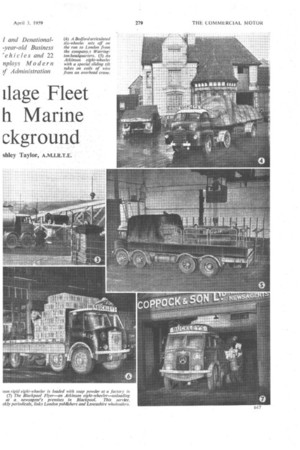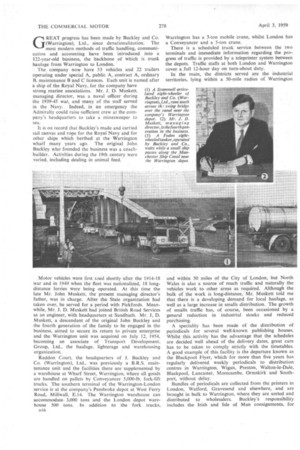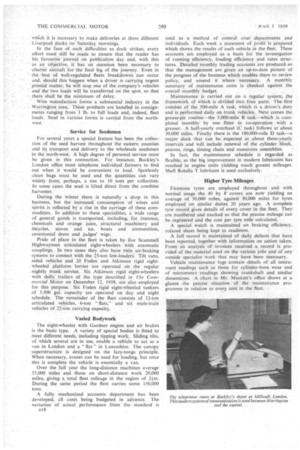tlage Fleet h Marine Aground
Page 65

Page 64

Page 66

If you've noticed an error in this article please click here to report it so we can fix it.
GREAT progress has been made by Buckley and Co. (Warrington), Ltd., since denationalization. The most modern methods of traffic handling, communication and accounting have been introduced into a 122-year-old business, the backbone of which is trunk haulage from Warrington to London.
• The company now have 53 vehicles and 22 trailers operating under special A, public A, contract A, ordinary B, maintenance B and C licences. Each unit is named after a ship of the Royal Navy, for the company have strong marine associations. Mr. J. D. Muskett, managing director, was a naval officer during the 1939-45 war, and many of the staff served in the Navy. Indeed, in an emergency the Admiralty could raise sufficient crew at the company's headquarters to take a minesweeper to sea.
It is on record that Buckley's made and carried sail canvas and rope for the Royal Navy and for other ships which berthed at the Warrington wharf many years ago. The original John Buckley who founded the business was a coachbuilder. Activities, during the 19th century were varied, including dealing in animal feed.'
Motor vehicles were first used shortly after the 1914-18 war and in 1949 when the fleet was nationalized, 18 longdistance lorries were being operated. At this time the late Mr. John Muskett, the present managing director's father, was in charge. After the State organization had taken over, he served for a period with Pickfords. Meanwhile, Mr. I. D. Muskett had joined British Road Services as an engineer, with headquarters at Sandbach. Mr. J. D. Muskett, a descendant of the original John Buckley and the fourth generation of the family to be engaged in the business, aimed to secure its return to private enterprise and the Warrington unit was acquired on July 12, 1954, becoming an associate of Transport Development, Group, Ltd., the haulage, lighterage and warehousing organization.
Raddon Court, the headquarters of J. Buckley and Co. (Warrington), Ltd., was previously a B.R.S. maintenance unit And the facilities there are supplemented by a warehouse at Wharf Street, Warrington, where all goods are handled on pallets by Conveyancer 5,000-lb. fork-lift trucks. The southern terminal of the Warrington-London service is at the company's Pembroke depot at West Ferry Road, Milhvali, E.14. The Warrington warehouse can accommodate3,000 tons and the London depot warehouse 500 tons. In addition to the fork trucks,
ol6 Warrington has a 3-ton mobile crane, whilst London has a Conveyancer and a 5-ton crane.
There is a scheduled trunk service between the two terminals and immediate information regarding the progress of traffic is provided by a teleprinter system between the depots. Traffic staffs at both London and Warrington cover a full 12-hour day on turn-about duty.
In the main, the districts served are the industrial territories, lying within a 50-mile radius of Warrington and within 50 miles of the City of London, but North Wales is also a source of much traffic and naturally the vehicles work to other areas as required. Although the bulk of the work is long-distance, Mr. Muskett told me that there is a developing demand for local haulage, as Well as a large increase in smalls distribution. The growth of smalls traffic has, of course, been occasioned by a general reduction in industrial stocks and reduced purchasing.
A speciality has been made of the distribution of periodicals for several well-known publishing houses. Whilst this activity has the advantage that the schedules are decided well ahead of the delivery dates, great care has to be taken to comply strictly with the timetables. A good example of this facility is the departure known as the Blackpool Flyer, which for more than five years has regularly delivered weekly periodicals to distribution centres in Warrington, Wigan, Preston, Walton-le-Dale, Blackpool, Lancaster, Morecambe, Ormskirk and Southport, without delay.
Bundles of periodicals are collected from the printers in London, Watford, Gravesend and elsewhere, and are brought in bulk to Warrington, where they are sorted and distributed to wholesalers. Buckley's responsibility includes the Irish and Isle of Man consignments, for
which it is necessary to make deliveries at three different Liverpool docks, on Saturday mornings.
In the face of such difficulties as dock strikes, every effort must still be made to ensure that the reader has his, favourite journal on publication day and with this as an objective, it has on occasion been necessary to charter aircraft for the final leg of the journey. Even in the best of well-regulated fleets breakdowns can occur and, should this happen when a driver is carrying urgent printed matter, he will stop one of the company's vehicles and the two loads will be transferred on the spot, so that there shall be the minimum of delay.
Wire manufacture forms a substantial industry in the Warrington area. These products are handled in consignments ranging from 1 lb. to full loads and, indeed, fleet loads. Steel in various forms is carried from the northwest.
Service for Seedsroen For several years a special feature has been the collection of the seed harvest throughout the eastern counties and its transport and delivery to the wholesale seedsmen in the-north-west. A high degree of personal service must be given in this connection. For instance; Buckley's London office must telephone individual farmers to .find out when it would be convenient to load. Spotlessly clean bags must be used and the quantities can vary widely from, perhaps, a ton to 10 tons per collection. In some cases the seed is lifted direct from the combine harvester.
During the winter there is naturally a drop in this business, but the increased consumption of wines and spirits is reflected by a rise in the carriage of these commodities. In addition to these specialities, a wide range of general goods is transported, including, for instance, chemicals and orange juice, structural machinery and bicycles, stoves and ice, boats and ammunition, ceremonial dress and judges' wigs.
Pride of place in the fleet is taken by five Scamnaeli Highwayman articulated eight-wheelers with automatic couplings. In two cases they also have twin air-braking systems to connect with the 25-ton low-loaders.. Tilt vans, sided vehicles and 20 Foden and Atkinson rigid eightwheeled platform lorries are operated on the regular nightly trunk service. Six Atkinson rigid eight-wheelers with dolly trailers of the type described in The Commercial Motor on December 12, 1958, are also employed for this purpose, Six Foden rigid eight-wheeled tankers of 3.500 gal. capacity are operated on day and night schedule. The remainder of the fleet consists of 12-ton articulated vehicles, 6-ton "flats," and six mule-train' vehicles of 22-ton carrying capacity.
Varied Bodywork
The eight-wheeler with Gardner engine and air brakes is the basic type. A variety of special bodies is fitted to meet different needs, including tipping work. Sliding tilts, of which several are in use, enable a vehicle to act as a van in London arid a "flat in Lancashire. The canopy superstructure is designed on the lazy-tongs principle. When necessary, cranes can be used for loading, but once this is complete the vehicle is essentially a van.
Over the full year the long-distance machines average 55,000 miles and those on short-distance work 20,000 miles, giving a total fleet mileage in the region of 21m. During the same period the fleet carries some 150,000 tons.
A fully mechanized accounts department has been developed, all costs being budgeted in advance. The
• variation of actual performance from the standard is D I 8 used as .a method of control over departments and individuals. Each week a statement of profit is prepared which shows the results of each vehicle in the fleet. These accounts are employed as a basis for the investigation of running efficiency, loading efficiency and rates structures. Detailed monthly trading accounts are produced so that the management are given an up-to-date picture of the progress of the business which enables them to review policy, and amend it where necessary. A monthly summary of maintenance costs is checked against the overall monthly budget.
Maintenance is carried out an a regular system, the framework of which is divided into four parts. The first consists of thc 500-mile A task, which is a driver's duty and is performed daily on trunk vehicles. Next comes the grease-pit routine—the 5,000-mile B task—which is completed monthly by one fitter in co-operation with a greaser. A half-yearly overhaul (C task) follows at about 30,000 miles. Finally there is the 180,000-mile D task—a major dock that can be expected at about three-yearly intervals and will include renewal of the cylinder block, pistons, rings, timing chain and numerous assemblies.
In fact, the maintenance schedule is regarded as flexible, as the big improvement in modern lubricants has resulted in engine units yielding much greater mileages. Shell Rotella T lubricant is used exclusively.
Higher Tyre Mileages
Firestone tyres are employed throughout and with normal usage the 40 by 8 covers are now yielding an average of 50.000 miles, against 30,000 miles for tyres employed on similar duties 20 years ago. A complete tyre record gives details of every cover in the fleet. They are numbered and marked so that the precise mileage canbe registered and the cost per tyre mile calculated.
A special watch is maintained on braking efficiency, refaced shoes being kept. inreadiness.
A full record is maintained of daily defects that have been reported, together with information on action taken. From an analysis of invoices received a record is provided of the material used on the various jobs and of any outside specialist work that may have been necessary.
Vehicle maintenance logs contain details of all instrument readings such as those for cylinder-bore wear and of micrometer readings showing crankshaft and similar dimensions. A chart in Mr. Muskett's office shows at a glance the precise situation of the maintenance programme in relation to every unit in the fleet.
































































































































